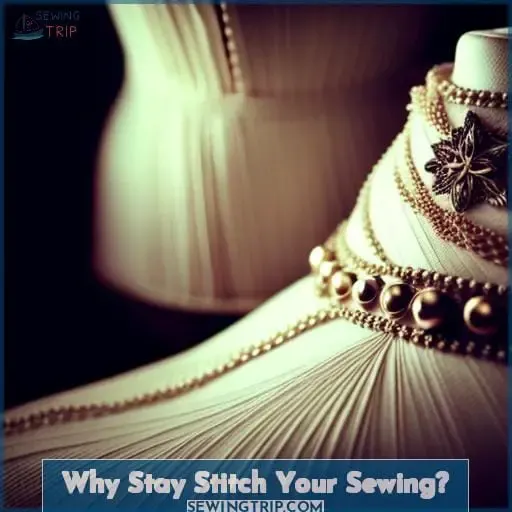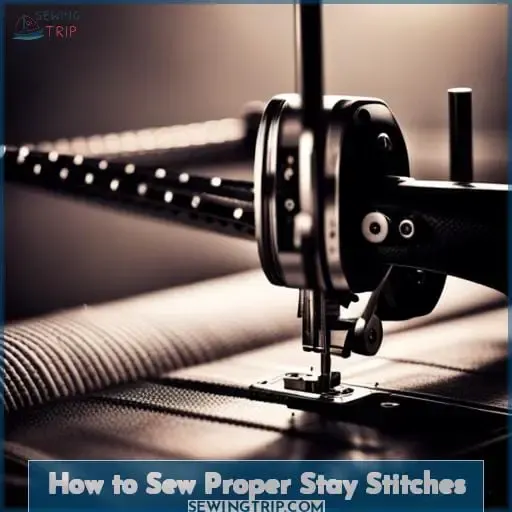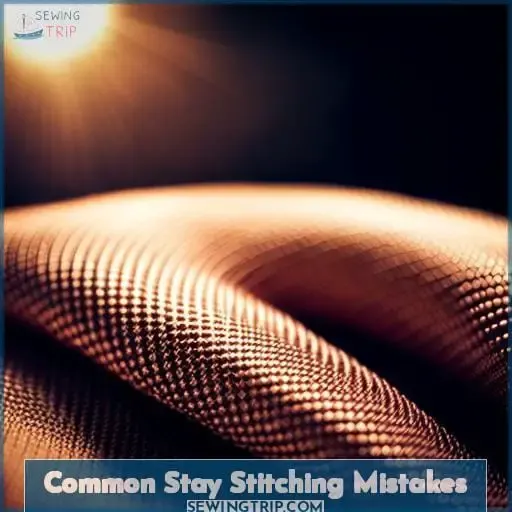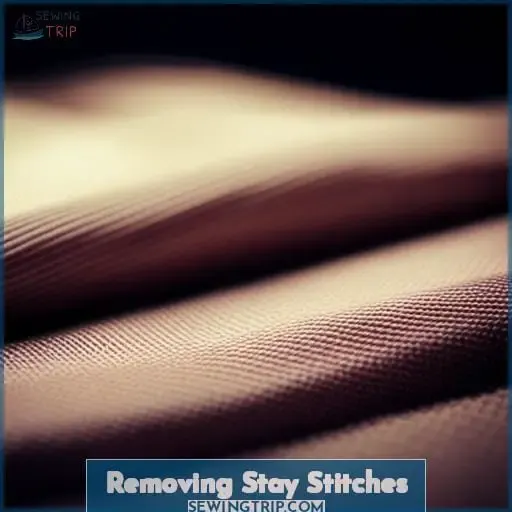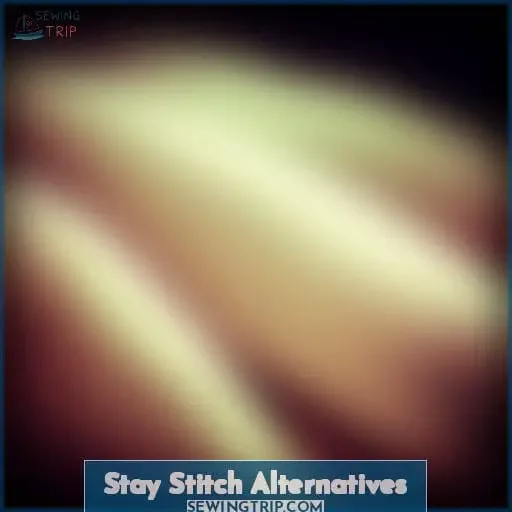This site is supported by our readers. We may earn a commission, at no cost to you, if you purchase through links.
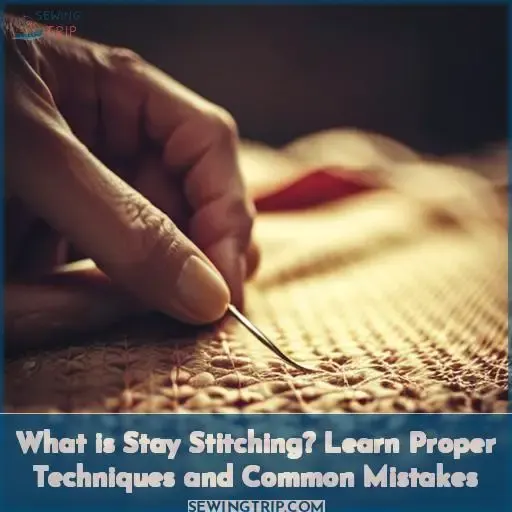 Don’t let your fabric’s shape fall victim to stretching and distortion.
Don’t let your fabric’s shape fall victim to stretching and distortion.
Stay stitching, a sewing technique used to stabilize fabric edges, is your secret weapon for achieving a flawless finish.
Learn the proper techniques and avoid common mistakes to ensure your garments maintain their intended shape and structure.
Discover when and where to apply stay stitching, and master the art of creating precise and effective stitches.
Table Of Contents
- Key Takeaways
- What is Stay Stitching?
- Why Stay Stitch Your Sewing?
- Where Should You Stay Stitch?
- When Should You Stay Stitch?
- How to Sew Proper Stay Stitches
- Should You Stay Stitch All Fabrics?
- Common Stay Stitching Mistakes
- Removing Stay Stitches
- Stay Stitch Alternatives
- Stay Stitching Tips for Success
- Frequently Asked Questions (FAQs)
- Conclusion
Key Takeaways
- Stay stitching involves sewing a straight stitch row on a single layer of fabric to stabilize curved and slanted edges.
- It prevents distortion and stretching during handling and sewing for a crisp finish.
- Common areas to stay stitch include curved edges like necklines and diagonal seams across the bias.
- Proper technique requires using a short stitch length and stitching from shoulder to center front/back for symmetry.
What is Stay Stitching?
Stay stitching is sewing a row of straight stitches on a single layer of fabric, usually after cutting out the pattern pieces but before construction.
As a garment construction technique, it serves to stabilize curved edges like necklines or slanted seams and prevent them from stretching out during handling and sewing.
By creating a ‘barrier’ just inside the seam allowance, stay stitching maintains the original shape of the fabric so the finished garment retains a crisp, professional look.
Sewn with a regular stitch length, stay stitches keep bias and curved edges from distorting.
Learning proper stay stitching technique and when to apply it helps sewists avoid common mistakes like puckered seams, gaping necklines, and misshapen garments.
Why Stay Stitch Your Sewing?
As a sewing instructor, I want to share why you should stay stitch your projects.
Stay stitching prevents distortion and maintains the intended shape of curved edges.
Knowing when and why to add this crucial step will improve your sewing skills and final results.
Prevents Distortion
By stay stitching, you’re preventing distortion on curved and diagonal edges before constructing seams.
- Stabilizes bias-cut fabric against stretching and fraying.
- Ensures symmetry when stitching both sides from the shoulder.
- Maintains the original shape and integrity of the fabric.
Maintains Shape
You’re also stay stitching to maintain the intended shape of curved and biased edges on your project.
| Location | Technique |
|---|
Where Should You Stay Stitch?
As a sewing instructor, I always tell my students to stay stitch curved edges and diagonal seams.
These areas are prone to stretching during construction, so stabilizing them with stay stitching is crucial.
Stay stitching parallel to the cutting line within the seam allowance will help maintain the shape of curved and diagonally cut fabric pieces.
Curved Edges
You’ll want to stay stitch curved edges like necklines and armholes to prevent them from stretching out during construction.
To ensure the best results, consider the following techniques:
- Use symmetrical stitching on both sides of the center for even tension.
- Choose a shorter stitch length, around 2.5mm, for woven fabrics.
- Hand sew if necessary for delicate or tricky areas.
- Explore alternative methods such as using fusible interfacing to prevent puckering.
Diagonal Seams
You can also stay stitch diagonal seams to prevent distortion.
These seams cut across the bias, the stretchiest part of the fabric.
Stay stitching diagonal seams maintains symmetry and fabric integrity.
Use a shorter stitch length of 2mm or less.
Clip into corners instead of stitching around them.
Consider alternative methods like stay taping for lightweight or sheer fabrics.
When Should You Stay Stitch?
Stay stitching is a key stabilization technique for curved and biased edges.
As a sewing instructor, I recommend stay stitching curved princess seams, style lines, armholes, and necklines immediately after cutting your fabric pieces.
By sewing simple straight stitches just inside the seam allowance, you preemptively reinforce edges prone to stretching or distortion.
I advise using a 2 to 2.5 mm stitch length and sewing symmetrically from the shoulders towards the garment center.
Carefully stay stitch curved waists, necklines, and princess seams first thing before constructing other areas.
This prevents frustrating puckers or misshapen seams later.
Though vital for bias-cut or curved pieces, avoid overdoing it on stable wovens.
How to Sew Proper Stay Stitches
As you prepare your fabric for construction, carefully consider stitch length and sewing direction when stay stitching.
Use a short 2.5mm stitch length and sew parallel to the cutting line within the seam allowance to prevent distortion.
Stitch from shoulder to center front/back and maintain symmetry for professional results.
Stitch Length
When sewing stay stitches, you’re aiming for a shorter stitch length of 2-2.5mm to keep the fabric stable.
This prevents the fabric from stretching while you construct your garment.
Experiment with thread colors to blend the stitches into your fabric.
Sew symmetrical lines on both sides of center for a clean, professional finish.
Check for even stretch by testing different stitch lengths on fabric scraps before constructing your project.
Sewing Direction
Start stitching a neckline from one shoulder point toward the opposite point to evenly distribute fabric stretch when stay stitching.
Always sew in the same direction on both sides to maintain fabric integrity.
For necklines, sew from shoulder point to shoulder point.
Use a short 2.5mm stitch length to prevent distortion.
Careful sewing direction prevents common mistakes like uneven stretching.
Should You Stay Stitch All Fabrics?
One should stay stitch all woven and knit fabrics to maintain shape, but tricot and very stretchy fabrics may not require it.
As experts in garment construction, we recommend stay stitching most fabrics except super-stretchy ones like spandex.
Stay stitching stabilizes the edges of woven and knit fabrics, preventing distortion.
However, tricot and very stretchy fabrics can lose their stretch if constrained too much.
When in doubt, test stitch a scrap first.
Stay stitch tightly woven fabrics and knits with a 2.5mm stitch length.
Use a 3mm length for more flexible knits to allow slight stretching.
Remember to sew symmetrical lines on either side of center for balance.
Stay stitching is essential for most fabrics, but alternatives exist for delicate materials unsuited to stitching.
Common Stay Stitching Mistakes
You’ll want to avoid a couple of common stay stitching mistakes that can undermine your hard work.
Using too long of a stitch length reduces control and may not properly prevent distortion.
Make sure to handle fabric carefully when stay stitching to avoid stretching or distorting curves.
When stay stitching curved edges like necklines, sew from shoulder to center front/back to ensure symmetrical stitching.
It’s also important to match thread color closely to your fabric. Contrasting thread shows through lighter fabrics.
Additionally, stay stitch all bias cut edges since they’re prone to stretching.
Take care not to catch facing pieces when stay stitching or you may end up with puckered seams.
Careful handling, symmetrical stitching, and proper stitch length help avoid common mishaps.
Removing Stay Stitches
After basting your pieces, carefully snip and remove those provisional stitches without distorting the fabric’s shape.
When unpicking stay stitches, take care not to stretch or distort the fabric. Gently tease the threads free using a seam ripper, snipping every few inches. For stubborn threads, slide a pin underneath to lift the stitches before cutting.
Stay calm, work slowly and methodically. Rushing leads to mistakes.
Once all threads are removed, press with an iron to reshape seam allowances or facing edges.
With practice, unpicking gets easier. Stay patient, breathe deep, and let the fabric guide you.
Stay Stitch Alternatives
Instead of stay stitching, you can opt for bracing stitches or taping curves when working with unstable fabrics. These alternatives provide similar benefits in stabilizing the fabric and preventing distortion.
- Bracing Stitches: Use different stitches like zigzag or stretch stitch to secure the edges of curved areas.
- Taping Curves: Apply fusible tape or washaway stabilizer along the curved edges to stabilize them before sewing.
By using these alternative techniques, you have more options to choose from based on your fabric type and preference. Experiment with different methods until you find what works best for your project.
Stay Stitching Tips for Success
Before sewing, ensure you’re using the appropriate stitch length and sewing direction for optimal results.
Use sharp shears and a rotary cutter for precision cutting.
Carefully handle cut fabric to avoid stretching edges.
Set your machine to a shortened stitch length, around 2mm, for better control.
Sew symmetrical lines from shoulder points to neckline centers.
This prevents puckering and distortion.
Frequently Asked Questions (FAQs)
How long should my stay stitching stitches be?
I recommend using a stitch length between 5-5 mm when stay stitching.
This shorter stitch prevents distortion in curved areas by holding the fibers securely without causing puckering.
Stitching too loosely risks stretching out the fabric shape.
For best results, test your stitch on scrap material first before sewing on your fashion piece.
What tools and supplies do I need for stay stitching?
You’ll need:
- Sewing machine
- Thread
- Fabric scissors
- Pins
- Seam ripper
- Iron
- Pressing cloth
Master staystitching by first practicing on scrap fabric to perfect tension, stitch length, and stitch direction before applying this technique to your project.
What kind of thread should I use for stay stitching?
- Use a thread that closely matches the color of your fabric when stay stitching.
- This helps the stitches blend in and not be visible on the outside of the garment.
- Typically, an all-purpose polyester or cotton thread works well.
- Staystitch with the grain as soon as your pattern piece is cut out.
How do I stay stitch on a serger/overlock machine?
Stay stitching on a serger simplifies the process.
Set a 2mm stitch length and 3-thread overlock stitch.
Serge within the seam allowance along curved edges to prevent distortion.
Remember to maintain control and feed fabric steadily.
Should I press or iron my fabric before or after stay stitching?
Iron your fabric before and after stay stitching.
Pressing the fabric first smooths it out to ensure accurate stitch placement.
Pressing after fixes the stitches in place, preventing any bunching or warping as you move on with constructing the garment.
Conclusion
Stay stitching keeps seams intact so your creation holds its form.
Whether curved, bias, or straight, anchoring edges prevents distortion.
Treat delicate fabrics gently, tightly woven ones confidently; both need this stabilizing care.
As pieces come together, reinforce edges first for a flawless finish.
With practice, even novices can implement this subtle yet vital technique.
Your garment deserves shape as imagined – skillful stitching makes it so.

